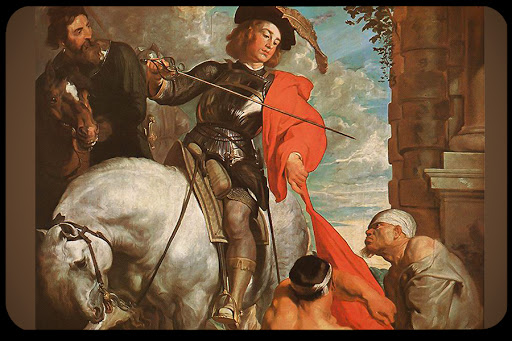It is a happy coincidence that Veteran’s Day falls on the feast day of St. Martin of Tours, patron of soldiers (among other occupations).
But there’s also a certain irony in this patronage. Martin was conscripted against his will into the Roman army at age 15 (under an edict that the sons of Roman soldiers also had to serve). He took the oath seriously and served as an officer in a unit whose duties were largely ceremonial, but several years later, after his baptism, Martin concluded on the eve of battle that he could not take part in the bloodshed, telling Caesar Julian (“the Apostate”): “I am a soldier of Christ. It is not lawful for me to fight.”
St. Martin is certainly best known for having cut in two pieces his lambswool-lined cavalryman’s cloak to give half to a nearly naked beggar outside the gates of Amiens where Martin was stationed. He would probably have given the man his whole cloak but for the fact that Martin, too, was nearly naked, having already given away much of his own clothing to those in need.
From his friend, disciple and biographer, Sulpicius Severus, we know a great many details of Martin’s life (316 – 397) – his birth in what is now Hungary, his pagan parents, his childhood in Pavia, Italy (where his soldier, later tribune, father was stationed), his desire from at least the age of ten to become a Christian, his founding of the oldest monastery in Europe, his unparalleled humility and charity, his conversion of thousands of pagans, and astonishing miracles which earned him the reputation of being a saint even during his life. These details can be found on many websites.
Less well known, perhaps, are some of the more spectacular miracles that God worked through the intercession of Saint Martin of Tours – raising three people from the dead, for example. Also remarkable was Martin’s success in bringing about the reconciliation of feuding groups, both bishops and monks.
First, to the miracles. According to Sulpicius’ account (portions of which are included in translation in “Medieval Saints: A Reader,” edited by Mary-Ann Stouck [1999]), not long after St. Martin established a monastery in Ligugé (five miles south of Poitiers), a catechumen joined the monks in Ligugé for instruction in the faith. While St. Martin was away traveling for three days, the unbaptised catechumen came down with a high fever and died. His body lay lifeless in one of the cells, awaiting burial. Martin, Sulpicius reports,
The other monks were naturally astounded, perhaps even more so when the catechumen (who’d been baptized immediately after his return to life) recounted what had occurred after his death:
The second restoration of a deceased person to life occurred not long afterward. When Martin was passing by the estate of a wealthy and highly respected man named Lupicinus, he heard a crowd shouting and wailing. It turned out that one of the family’s slaves had hanged himself. Again, Martin asked the crowd to wait outside,
The third miracle of bringing a dead person back to life was even more stupendous. A huge throng of pagans approached St. Martin, now a bishop, on the road when he was traveling one day. The crowd was surrounding a woman whose child lay dead in her arms. They had heard of Martin’s miracles and were determined to accompany her in search of Martin. Fr. Albert Hebert, S.M., author of “Saints who Raised the Dead” (2004) tells what happened next:
The crowd heard. They saw the reasonableness of the woman’s challenge. Ma
rtin knew that for the salvation of all these poor people God would not refuse him. He took the child into his arms, knelt down, and prayed. The multitude was silent, expectant. … Martin finished his prayer, and then arose with a living child in his arms! H
e handed the child over to his mother.
To the end of his life, he sought reconciliation and brotherhood among Catholics during a period of doctrinal confusion and heresy. Eileen Heffernan, FSP recounts in her book “Fifty-Seven Saints” that Saint Martin had gone to visit some monks who had requested his guidance. When he arrived, they were arguing. Martin “scolded” them:
In fact, serving God in joy is a fitting summation of Saint Martin’s life. After his death, his successor BIshop Gregory of Tours filled four volumes with accounts of Martin’s posthumous miracles.
Susan E. Wills is spirituality editor of Aleteia’s English-language edition.

